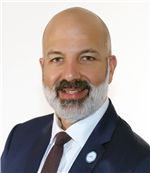Student Success Is Measured in Opportunities, Not Credits
 Buck is a senior at Harding High School. He will graduate this spring, and will enter the University of Minnesota’s College of Continuing and Professional Studies in the fall, where he plans to earn a bachelor’s degree in construction management.
Buck is a senior at Harding High School. He will graduate this spring, and will enter the University of Minnesota’s College of Continuing and Professional Studies in the fall, where he plans to earn a bachelor’s degree in construction management.
At 18, Buck already knows what he wants to be when he grows up. He’s completed multiple internships, earned three professional certifications and a scholarship from OSHA, gained college credit at Saint Paul College, and taken classes related to his passion including woodworking. He’s done all of this while taking core classes in math, science, language arts, social studies and other subjects that align with Minnesota graduation requirements.
Buck is one of countless students in Saint Paul Public Schools who have been able to discover and pursue their passions while earning their high school diploma. His story illustrates what I want for every one of our graduates. By giving students access to a wide range of opportunities, letting them make choices about their education, and making those experiences available at all of our schools, we are guiding our young people as they pave their own paths to success.
As reported in the Pioneer Press, Saint Paul Public Schools announced that all of our high schools will require 86 credits for graduation starting with the class of 2022. Prior to this year, students at some of our high schools had to earn 110 credits to graduate, while other schools required 94 or 86. Now, every student will be able to graduate with a minimum of 86 credits no matter what school they attend.
It’s important to know that the number of core credits required—including math, science, language arts, social studies, art, physical education and health—is not changing. In fact, the district’s new requirements remain more rigorous than state standards by requiring one semester of career and technical education and, starting with this year’s freshman class, a semester of Critical Ethnic Studies.
The biggest change is the number of electives required. If a student previously had to earn 44 elective credits and now they only need 20, what will they do with that extra time? Many will use it to take more advanced classes in math, science or another core subject, as they’ve always done. Others may choose to expand their knowledge of world languages such as Spanish, Chinese or Ojibwe, hone their skills in painting or dance, or get an introduction to engineering or architecture.
Or, they may choose to do a deep dive into what could become their future career. Starting in kindergarten, every SPPS student begins to create what we call a personal learning plan. As they progress through elementary and middle school, they are exposed to potential careers that match their interests and strengths in age-appropriate ways. By high school, they can choose a pathway such as healthcare, business or technology, take a series of progressive classes, and complete internships to gain the skills and knowledge they need to turn their passion into a rewarding future.
This change to our graduation requirements also makes it possible for students who need to work to support their families, or need more time to catch up, to do just that. By responding to the individual needs of each student, we are creating schools that prepare students for the next phase of their lives, rather than forcing them to follow a roadmap they had no role in creating.
Will reducing the number of credits required lead to higher graduation rates? It’s possible, but we don’t have any data to support that it actually will. We’d be fooling ourselves to say that this small change will reverse decades of inequitable student outcomes, particularly in a state known for one of the largest achievement gaps in the country.
If our graduation rates increase, particularly for students of color, English learners, low-income students and students in special education, it will be due to a combination of many factors. As superintendent, my goal is not higher percentages on a state report. What truly matters is that more students graduate with the skills they need to succeed in life after high school and beyond.
I don’t know how many credits Buck will have when he graduates this spring. But I do know that when he and thousands of his peers walk across that stage, they will be better prepared for college, career and life because of the opportunities they had in Saint Paul Public Schools.
In Partnership,

Joe Gothard, Superintendent




